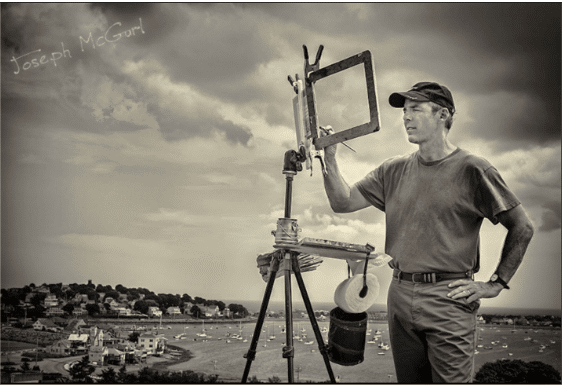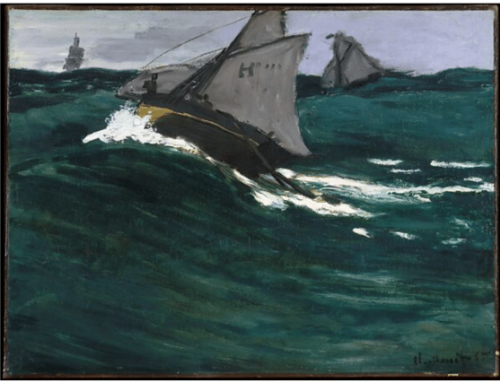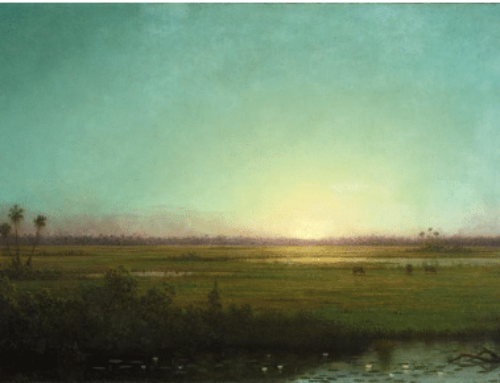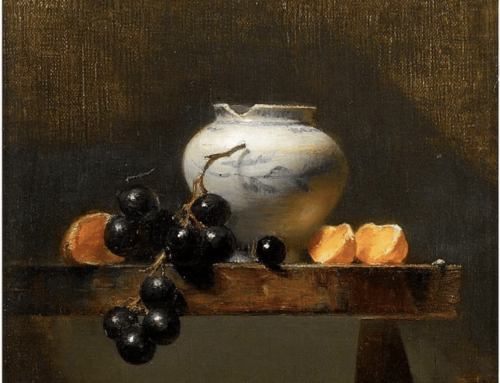First, congratulate yourself for even getting as far as contemplating doing this: painting nature as it appears to your mind and senses is an extraordinary way of relating to yourself and the world! It begins with looking – really looking in a way most people rarely slow down to do. Next it becomes about interpretation and the challenging question of what will you make of what you see?
To follow the path of the artist is to learn that nature rarely deigns to cooperate with the best aesthetic principles of design; there’s a LOT to look at out there! One way to “find” the painting in the landscape is to use a viewfinder.
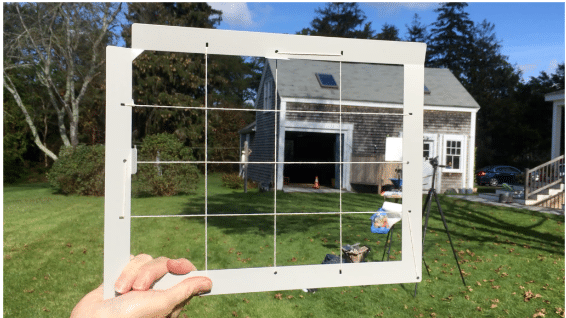
You can absolutely find a good composition in nature using a viewfinder. However, for that painting to be as strong as it can be, you’re going to have to do at least some editing, some exaggerating, minimizing, editing out or adding in. The larger challenge, perhaps, is forgetting all that long enough to take the crucial first step, one that has little or nothing to do with anything technical at all.
That first step should be about feeling. Most pros look and select something to paint not because it falls perfectly within their viewfinder, but because it strikes a chord, calls to them, hits them in the gut, makes the heart leap. Then they use the viewfinder to support that first burst of interest and excitement – it helps figure out the proportions of the motif relative to the four-sides of the canvas and make it easier to select, modify, or remove elements for as strong a composition as can be made around it.
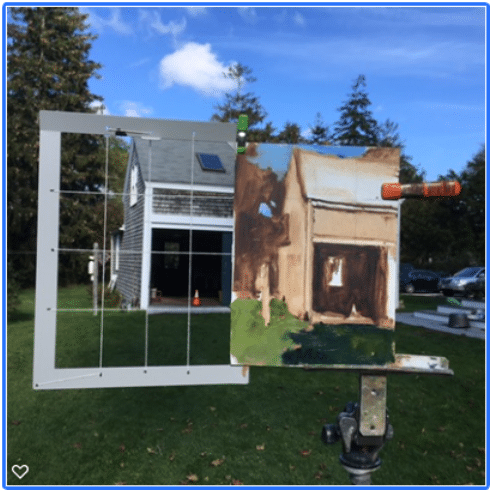
Joseph McGurl lines up his canvas with the viewfinder and uses umber acrylic paint to sketch out the scene and make a mono-chromatic underpainting. When the acrylic base is dry, he begins to paint over it with oils.
That visual thing which inspires a vision and the desire to paint it is known as a motif; it’s the main idea, the motive for making that particular painting. Compose around THAT; everything in the painting should support the motif.
A good motif is something that’s interesting and exciting to you and that you think will be interesting and exciting to other people – a great tree, an awesome light effect, a striking relationship between shapes and lines, values and colors in space.
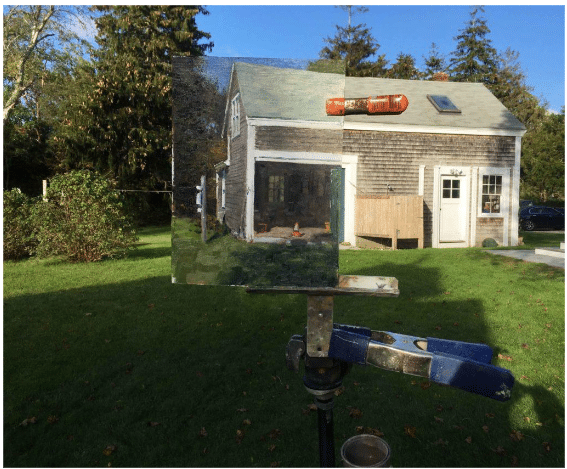
Strong plein air compositions use what some call leading lines to sort of take the viewer by the hand and lead the viewer into the painting. They use directional lines to keep the viewer moving around within the four sides of it (pointedly NOT giving the viewer anything like an exit sign with an arrow pointing exit this way over here.) See how, in the above plein air sketch by Joseph McGurl, he’s selected leading lines from the downward-pointing pines to the left and right and added leading lines in the foreground by adjusting the existing shadows to point inward toward the center.
So here’s our two-step, rule-of-thumb process:
- Select a meaningful motif and define it as the painting’s main idea, what the painting is “about” (e.g., “That tree.”). Think of it as containing the main point of interest
- Design the rest of the painting to highlight and focus on it, to fill the frame with it and support and lead the eye in, around, and always returning to that point (call it the “All Roads Lead to the Point of Interest” approach).
To sum up: the most rewarding plein air process is about selecting a truly compelling feature within the landscape and using the viewfinder to help compose a strong composition around that motif.
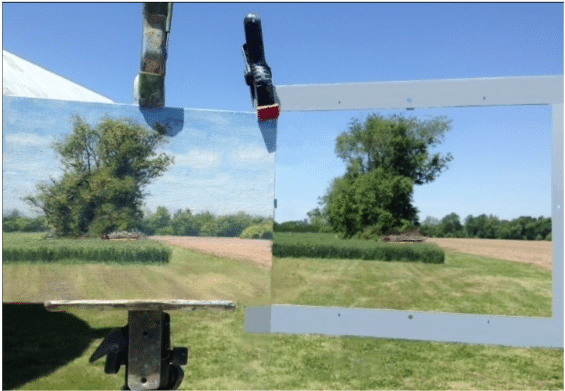
Joseph McGurl’s viewfinder approach in action. Although the motif seems dogmatically copied, you can find many subtle “improvements” of line, angle, proportion, value, temperature and other modifications (such as the addition of clouds that may or may not have been there at some point in exactly that formation).
Selection and Composition.
The first step, selection, is about feeling and the second step, composition, is technical. So let’s say you’ve found something you can’t wait to paint, and you’ve used a viewfinder to scope out a composition around it. Now what?
A sound way to start a painting is with an underpainting sketch (McGurl uses acrylic for this). Oil work too, provided they’re thinly layered enough. Use anything relatively neutral such as an earth like umber, perhaps darkened with a little ultramarine blue, to “block in” the “big shapes” on the canvas, starting with the shadows. Simplify what you see into three or four large shapes and/or a single point of interest. You then design the painting within those shapes, relating them to each other and the viewer. That’s composition.
Good luck and remember that it’s a process. Don’t expect to create outstanding plein air paintings from day one. Don’t compare your work unfavorably to others either, unless it’s to figure out what you can do to make your next painting stronger.
The best advice of all might come down to this: be kind to yourself and just enjoy being outside and moving paint around instead of working or doing whatever chores you usually have to do!
Joseph McGurl shares his techniques in two videos, one on light and one on light and atmosphere, and one on advanced landscape painting. Check them out here.
Deep Dive: How Joseph McGurl Uses Sight-Size Drawing
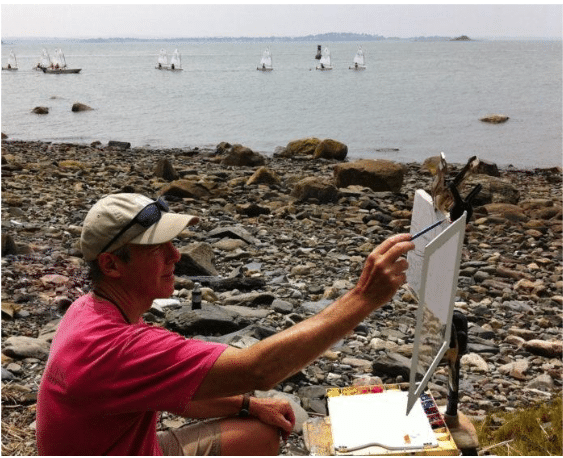
“Luminist” Joseph McGurl’s search for a deep connection to nature has led him to the decision not to use photography as reference.
“I’m interested in painting the world, not a photograph of the world,” he says. “For me, the magic of art is taking a multi-dimensional experience and translating it into two dimensions. If you use a photograph, then the camera has already done that for you, and all you can do is take the two-dimensional image and make another version of it. That is very boring to me. The excitement of painting is recreating the experience, even if you are making things up based on the experience. That’s where the fun is.”
He is a champion of a technique known as sight-size drawing, an approach that can yield very accurate drawing and can also be a considerable aid to composing a painting. For a deep dive on how he uses an open frame viewfinder, read on.

